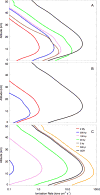TERRESTRIAL EFFECTS OF NEARBY SUPERNOVAE IN THE EARLY PLEISTOCENE
- PMID: 30034771
- PMCID: PMC6052446
- DOI: 10.3847/2041-8205/826/1/L3
TERRESTRIAL EFFECTS OF NEARBY SUPERNOVAE IN THE EARLY PLEISTOCENE
Abstract
Recent results have strongly confirmed that multiple supernovae happened at distances of ∼100 pc, consisting of two main events: one at 1.7-3.2 million years ago, and the other at 6.5-8.7 million years ago. These events are said to be responsible for excavating the Local Bubble in the interstellar medium and depositing 60Fe on Earth and the Moon. Other events are indicated by effects in the local cosmic ray (CR) spectrum. Given this updated and refined picture, we ask whether such supernovae are expected to have had substantial effects on the terrestrial atmosphere and biota. In a first look at the most probable cases, combining photon and CR effects, we find that a supernova at 100 pc can have only a small effect on terrestrial organisms from visible light and that chemical changes such as ozone depletion are weak. However, tropospheric ionization right down to the ground, due to the penetration of ⩾TeV CRs, will increase by nearly an order of magnitude for thousands of years, and irradiation by muons on the ground and in the upper ocean will increase twentyfold, which will approximately triple the overall radiation load on terrestrial organisms. Such irradiation has been linked to possible changes in climate and increased cancer and mutation rates. This may be related to a minor mass extinction around the Pliocene-Pleistocene boundary, and further research on the effects is needed.
Keywords: astrobiology; cosmic rays; planets and satellites: atmospheres; supernovae: general.
Figures


References
-
- Alberts WG, Bartlett DT, Chartier JL, et al. J ICRU. 2001;1:17.
-
- Atri D, Melott AL. RaPC. 2011;81:701.
-
- Atri D, Melott AL, Thomas BC. JCAP. 2010;05:008.
-
- Avillez MA, Breitschwerdt D. A&A. 2005;436:585.
-
- Bambach RK. AREPS. 2006;34:127.
Grants and funding
LinkOut - more resources
Full Text Sources
Other Literature Sources
